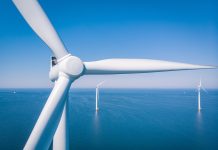More than 60 years ago, Moog Components Group, originally called Electro-Tec, was started by two brothers George and James Pandapas in Blacksburg, Virginia. This first plant manufactured miniature slip ring assemblies.
In 1953, the two brothers decided to go their separate ways and pursue different avenues. This led James to found Poly-Scientific where he and his team engineered the plating technologies that would eventually lead them to develop high-performance slip rings.
The company has grown dramatically since its humble beginnings in the basement of a building in downtown Blacksburg. What began with some slip rings and a few conductors has evolved into a leading supplier in motion control, air moving, electronics and fiber optics, addressing critical performance applications and expanding into multiple industries, including aircraft, defense, medical, industrial, and marine and wind energy. Moog Inc. is a worldwide designer, manufacturer, and integrator of precision control components and systems. Moog’s high-performance systems control military and commercial aircraft, satellites and space vehicles, launch vehicles, missiles, automated industrial machinery, wind energy, marine, and medical equipment.
“The motor technology we’re into now has made us into a motion control company, meaning anything that has to rotate, be driven, and controlled, or power data that has to be transferred across a rotary interface,” said Steve Black, the senior business development manager at Moog Components Group.
Because Moog is an engineering-driven company, it offers the wind market the highest level of reliability and performance that’s out there in the slip ring world, according to Black.
“I would say that we have, without question, the best technologists and materials labs in the world within our facilities,” Black said. “We know sliding contacts better than anybody else in the world, and that’s what we use to develop the products.”
 However, with that high level of quality comes a high cost. And according to Black, the price is what initially turned OEMs in the wind energy market away from doing business with them.
However, with that high level of quality comes a high cost. And according to Black, the price is what initially turned OEMs in the wind energy market away from doing business with them.
“We’re not the cheapest option out there, and we never intended to be,” Black said. “What we provide and what we focus on is the highest level of performance. Where things are critical and where it’s important that you have the high-performance products, that’s where we’re strong. It’s what we do every day, and it’s what led us into the wind business.”
Prior to 2008, Moog set its sights on the pitch control slip ring business within the growing wind industry. However, it has never been a low-cost supplier, and the OEMs that were cost-focused on the parts going in their turbines couldn’t agree to pay Moog’s higher prices.
That’s when Black and his team at Moog Components Group decided it was time to take their slip ring products directly to the owners and operators.
“We knew that they were going to have a high focus on the maintenance of the turbines and lowering maintenance costs would be a high level of concern for them,” Black said. “We developed our product, came up with our initial design concept, and took it out and started talking to wind site technicians. I would like to be able to say that it was my idea, but it just so happened that those were the guys who wanted to talk to us. They were the ones who were dealing with it more than anyone else, every day.”
Wind turbines require reliable transmission of power and data signals from the nacelle to the control system for the rotary blades. Moog’s slip rings provide the performance and quality needed in demanding environments. While the cost up front may be high, they eliminate costly downtime by using fiber brushes and robust mechanical components in the slip ring design, ultimately allowing their customers to save on long-term costs.
According to Black, he and his team at Moog Components Group felt pulled toward the wind industry because they knew that the slip rings could be better.
“We knew that we had a better technology, and we knew that we could reduce the maintenance requirements,” Black said. “We also knew that we could reduce the downtimes that turbine technicians saw because of nuisance issues with pitch control slip rings. We had a proven reliable technology that we had been building for years that could make things better for the owners and operators.”
However, in any business case where you’re looking to do something better, the potential volume to support it must be out there. That’s when Moog started looking at what was going on in the wind industry with the current install base and with the growth potential within the wind market.
“We saw a great business case to make a big impact with a product in the aftermarket and to start building the reputation for performance and reliability that we knew the wind owners and operators would be demanding,” Black said. “We looked at it in a twofold approach in that we’d get the units out there and then get the technology proven and accepted. We would use that as a strong base to re-engage the OEM market.”
When Moog Components Group was able to get those audiences and show the wind technicians what they had to offer in terms of its pitch control slip ring technology, they were able to get the feedback they needed to create slip rings with the highest level of performance and reliability.
“We made modifications, changed our design, and did things to improve the interface for the technicians to do the installations,” Black said. “That’s how our product was developed — with the guys who were working on them every day. Even today, I don’t think there’s any parallel to what we offer turbine technicians in terms of reliability and performance.
“We started shipping the product in 2009. We have thousands of the products out in the field now, and the performance has just been exceptional.”
As a supplier of an aftermarket product for GE Renewable Energy, Moog is working with all of the major operators of GE turbines. In addition to its pitch control slip rings, Moog has also made a name for itself with its fiber brush technology, which dates back to the early 1980s when Moog developed its fiber brush for NASA’s satellite applications.
Satellites had two primary challenges with a solar ray drive that must continuously point at the sun: the requirement for lubrication and the significant amount of wear debris generated in the process. Moog developed the fiber brush to eliminate both of those problems and to improve the operation of satellites.
“Obviously, a service call to space can be extremely expensive,” Black said. “That was the genesis for the fiber brush design we use. Since that product release in 1991, our fiber brush technology has become a significant part of our product line.”
According to Black, the wind industry doesn’t show any signs of abating, and with a company like Moog and its slip ring technology inside of the turbines, the blades are set to keep spinning.
“From watching it all these years, I believe it’s getting stronger and stronger every year,” Black said. “It’s exciting to see that the productivity of the wind sites now and, with GE as an example, the different iterations they’ve come out with and the improvements with software, performance, and blade sizes and what they’re doing to access the lower wind areas. It’s been interesting watching the technology grow and develop in the years I’ve been involved. Overall, I think the wind industry business is a tremendous asset to our economy, and we at Moog are proud to be involved in such a growing industry.”
For more information, go to www.moog.com.



























